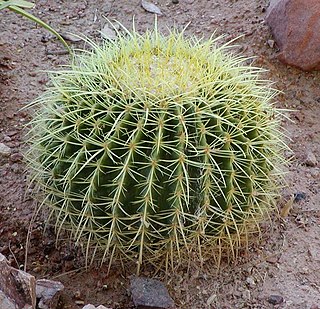
Barrel cacti are various members of the two genera Echinocactus and Ferocactus, found in the deserts of Southwestern North America. Some of the largest specimens can be found in the Mojave Desert in southern California.

Ferocactus is a genus of large barrel-shaped cacti, mostly with large spines and small flowers. There are about 30 species included in the genus. They are found in the southwestern United States and northwestern Mexico.

The Mexican darter, also known as the Chihuahua darter or Mexican darter, is a species of freshwater ray-finned fish, a darter from the subfamily Etheostomatinae, part of the family Percidae, which also contains the perches, ruffes and pikeperches. It is endemic to Mexico where it is the only species of darter to naturally occur in the Pacific drainage. This species can reach a length of 5.5 centimetres (2.2 in) TL.
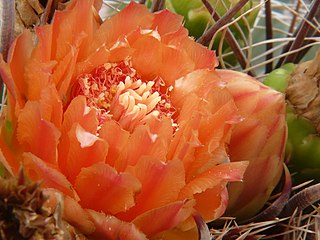
Ferocactus wislizeni, the fishhook barrel cactus, also called Arizona barrel cactus, candy barrel cactus, and Southwestern barrel cactus, is a species of flowering plant in the cactus family Cactaceae, native to northern Mexico and the southern United States. It is a ball-shaped cactus eventually growing to a cylindrical shape, with spiny ribs and red or yellow flowers in summer.

Ferocactus cylindraceus is a species of barrel cactus which is known by several common names, including California barrel cactus, Desert barrel cactus, and miner's compass. It was first described by George Engelmann in 1853.

Ferocactus latispinus is a species of barrel cactus native to Mexico. Originally described as Cactus latispinus in 1824 by English naturalist Adrian Hardy Haworth, it gained its current name in 1922 with the erection of the genus Ferocactus by American botanists Britton and Rose. The species name is derived from the Latin latus "broad", and spinus "spine". Ferocactus recurvus is a former name for the species.
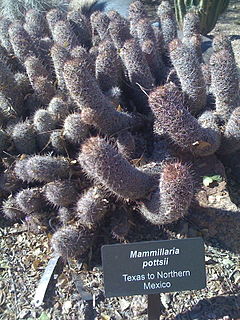
Mammillaria pottsii, also known as fox-tail cactus or rat-tail nipple cactus, is a species of flowering plant in the family Cactaceae. It was first described by Scheer ex Salm-Dyck, Cact. Hort. 1849: 104 (1850) According to the United Nations Environment Programme, M. leona is a synonym for M. pottsii.

Ferocactus peninsulae is a barrel cactus in the genus Ferocactus of the family Cacteae.

Ferocactus alamosanus is a species of Ferocactus from Mexico. The specific epithet, alamosanus, refers to the plant's occurrence at Álamos in the Mexican state of Sonora, in northwestern Mexico.

Ferocactus chrysacanthus is a species of Ferocactus from Mexico.

Ferocactus diguetii is a species of Ferocactus from Mexico.
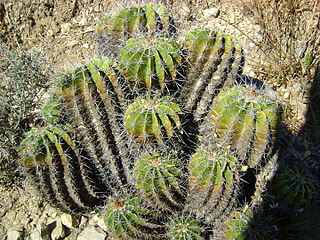
Ferocactus flavovirens is a species of Ferocactus from Mexico.

Ferocactus gracilis is a species of Ferocactus from Mexico.

Ferocactus townsendianus is a species of Ferocactus from Mexico.

Ferocactus santa-maria is a species of Ferocactus from Mexico.

Ferocactus schwarzii is a species of Ferocactus from Mexico.
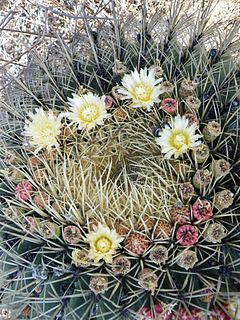
Ferocactus histrix is a species of Ferocactus from Mexico.
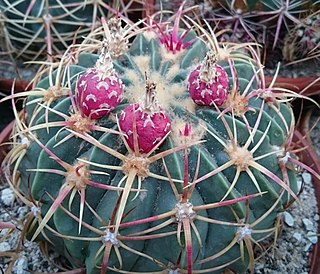
Ferocactus macrodiscus is a species of Ferocactus from Mexico.
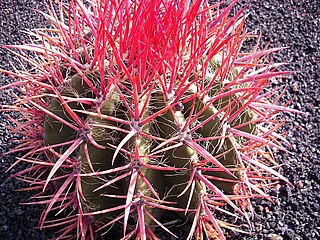
Ferocactus haematacanthus is a species of Ferocactus from Mexico.

Croton pottsii is a species of plant known by the common name leatherweed. It is native to the southwestern United States and northern Mexico.




















